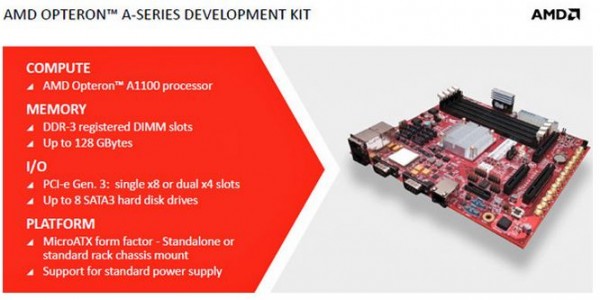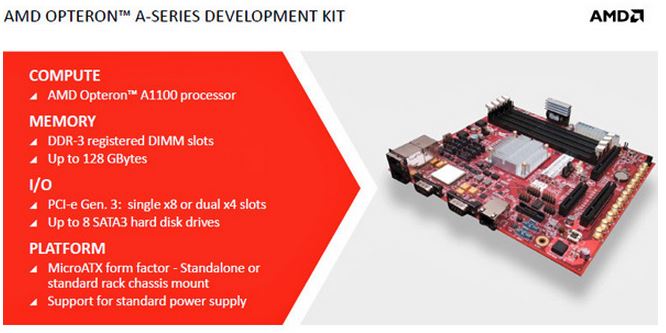AMD announced the availability of the AMD Opteron A1100 development platform. This is exciting news as it expands the availability of the ARMv8 based AMD platform. We have been waiting, for years now, to start seeing volume ARM server deployments outside of bleeding edge organizations such as Google. Now we are seeing those entrants, almost, hit general availability.
The specs of the development platform are straightforward:
- An AMD Opteron A1100-Series processor with 4 cores
- 2 Registered DIMM with 16 GB of DDR3 DRAM
- PCI Express connectors configurable as a single x8 or dual x4 ports
- 8 Serial-ATA connectors
- Compatibility with standard power supplies
- Standard UEFI boot environment
- Linux environment based on Fedora technology from the Red Hat-sponsored Fedora community
- Standard Linux GNU tool chain, including cross-development version
- Platform device drivers
- Apache web server, MySQL database engine, and PHP scripting language for developing robust Web serving applications
- Java 7 and Java 8 versions to enable developers to work in a 64-bit ARM environment
The high-point is clearly the 8x SATA connectors. It seems as though AMD has a seriously constrained $3000 platform. We saw a picture of this platform during the Seattle launch press releases.

The processors are quad ARM Cortex A57 design. This is the 64-bit processor we are eagerly awaiting. Unfortunately, the processor is quad core while the AMD A1100 is specificed to be either a 4 core or 8 core part. The $3000 developer kit uses the lower end 4-core variant.
The development platform comes with 8x SATA3 and DDR3 memory slots. Frankly, DDR4 modules are still in limited supply (as of July 2014) so the choice to put out DDR3 development platform makes sense.
Overall, this is a step in the right direction. On the other hand, these are expensive platforms that do not offer the full potential of ARMv8 performance. We certainly look forward to generally availability at less than 1/10th the development kit’s $3000 pricing.





$3000 for a development board housing a $10 smartphone CPU ? I’m having a hard time seeing the strategic value in this. A month ago they were trying to position the A1100 as a “game changer” for LAMP. I don’t see what this gimped non-x86 chip can do that isn’t already satisfied by a $99 Athlon. Sure, you can cram a few more of these low-power boards per circuit, but since the board is more power-hungry than the CPU itself, performance/watt won’t be that great, with the bonus that you’re now stuck on a proprietary non-x86 platform.
Sorry, I just don’t see it happening. Even if they were giving these dev boards away, it feels like a half-assed solution to a fabricated problem.
Uh, yeah, please list the “$10 smartphone CPUs” that have onboard 8x SATA, 8x PCI lanes, 2x 10Gb ethernet, etc. I’m not sure what part of the board you think is sucking up that much power since the chip is an SoC and besides memory modules, sockets, passive components, the odd optional physical interface and the PCB, it requires no other components.
You’re missing the point entirely. The point is the combination of price, performance and power usage. This chip, and others like it from other vendors will beat Intel hands down.
The fact that you think ARM is “proprietary” and “x86” is not speaks for itself. ARM is an open architecture that manufacturers can licence and modify as they see fit.
Intel is essentially a monopoly but there are many manufacturers building ARM chips for servers. Competition and innovation in designs will solidify Intel’s position as a lumbering and irrelevent legacy manufacturer.